How to Create an Acknowledgement Statement for Your Employee Handbook
Adding an acknowledgement statement in your employee handbook is not just a formality. It’s a safety net to document that your employees have received your handbook. Some acknowledgement statements go even further, asking employees for additional confirmation such as reading, understanding, or saying that they’ll comply with the policies included in the handbook.
But first, let’s understand the role of an employee handbook. It’s a fundamental document that helps you set expectations, guidelines, and policies for everyone in the company. Because your handbook is rich with content, it’s important to collect employee acknowledgement.
Here’s a guide to help you understand why you need an acknowledgement statement and how to make yours as effective as possible.
Understanding the Importance of Acknowledgment Statements
An acknowledgement statement in your employee handbook is akin to a signature page. At a minimum, it’s the place where employees acknowledge receipt of the handbook. Taken a step further, the acknowledgement statement can request confirmation that they’ve read your handbook — and, even more, that they understand it. In the most thorough cases, companies may ask employees to agree to comply with the policies within.
Keep in mind that each additional layer of employer protection within the acknowledgement statement — received, read, understood, will comply — may lead to more questions or hesitation when it comes to signature time. Some companies opt to keep it simple by asking employees to acknowledge receipt only, while others may have the bandwidth to field the questions or concerns that arise as employees thoroughly review the handbook content.
While it’s not mandated by law to have employees sign or acknowledge the handbook, it’s considered best practice as it reduces employer risks considerably. This documentation is invaluable especially during disciplinary situations, audits, or legal disputes.
Without this acknowledgment, an employee might claim they were unaware of company policies. This can lead to legal and practical complications. By documenting the distribution process and collecting signatures, your company is protected if disputes arise. It safeguards your employees, too, by providing clear policies, procedures, and expectations.
How to Draft an Effective Acknowledgement Statement
Step 1: Make your acknowledgement statement clear
First and foremost, a successful acknowledgment page is clear and easy to understand. It should convey your handbook’s primary aims and objectives. In most cases, an employee handbook focuses on policies, procedures, and workplace expectations. (We believe your handbook should highlight your company culture, too!)
Step 2: Confirm receipt of the handbook
Merely distributing your handbook may not be enough should issues arise. Therefore, a line that attests to the receipt of the handbook by the employee is crucial. It’s essential for record-keeping and is helpful in cases of employee noncompliance. By acknowledging the receipt of the handbook, employees can’t later claim ignorance about the handbook’s existence.
Step 3: Agree to read its content (optional, but recommended)
So, you’ve asked employees to acknowledge receipt, but do you want them to affirm that they’ve read it? Obviously you want your employees to become familiar with your handbook content, but, as mentioned earlier, this step can slow down the signature collection process. This is ultimately a matter of company preference.
Step 4: Affirm understanding (optional, but recommended)
Asking employees to acknowledge that they’ve received and read the handbook is one thing, but confirming they understand it is another. When you include language that affirms handbook comprehension, employees are more incentivized to read the content with the intention to grasp it. You can also take this opportunity to encourage employees to approach HR or their supervisor if anything is unclear.
Step 5: Emphasize it’s not an employment contract
An employee handbook, even with an acknowledgment statement, does not constitute a binding employment contract. While the handbook is a formal document, employee acknowledgement is simply that — an acknowledgement, not an agreement. It doesn’t guarantee employment or other terms and conditions. Signing the handbook carries weight, as explained above, but it’s essential to remind employees that the handbook is not an employment agreement or contract. This is especially true when it comes to at-will employment, which means employees can be terminated without cause. This distinction ensures both parties are clear about the nature and implications of the acknowledgment and their employment relationship.
Step 6: Stress that the handbook will change
In a dynamic work environment, changes are inevitable. Be sure employees recognize that the handbook content will evolve for various reasons, such as market changes, legal updates, or company growth. Reassure employees that they’ll be kept in the loop regarding any changes — and make sure to follow through on that promise. You can also state that you will do your best to communicate updates to employees, but ultimately it is up to them to review your policies regularly to ensure they have the latest information.
Step 7: Collect the signature and note the date
Don’t forget the final step: collect signatures! This is critical regardless of whether you confirm the handbook was (1) received, (2) received and read, (3) received, read, and understood, or (4) received, read, understood, and will comply with. It’s also important to record the date and time when signatures are collected. This ensures you’re recording exactly what version of your handbook the employee has received and is signing off on.
3 Acknowledgement Statements to Spark Ideas
At Blissbook, we prioritize crafting content that puts culture at the forefront. However, it’s best to keep acknowledgement statements straightforward and inject the fun throughout the rest of the handbook.
Here are three examples of effective acknowledgement statements.
Example #1: Acme Incorporated Acknowledgement Statement (a Blissbook template!)
Check out this digital acknowledgement statement from the Acme Incorporated Employee Handbook. What’s cool is that if you hop onto Blissbook, this is the go-to language you’ll start with. And since the policy details are tucked away under those ‘Read-More’ buttons, we ask folks to make sure they’ve clicked on them and gone through the whole text.
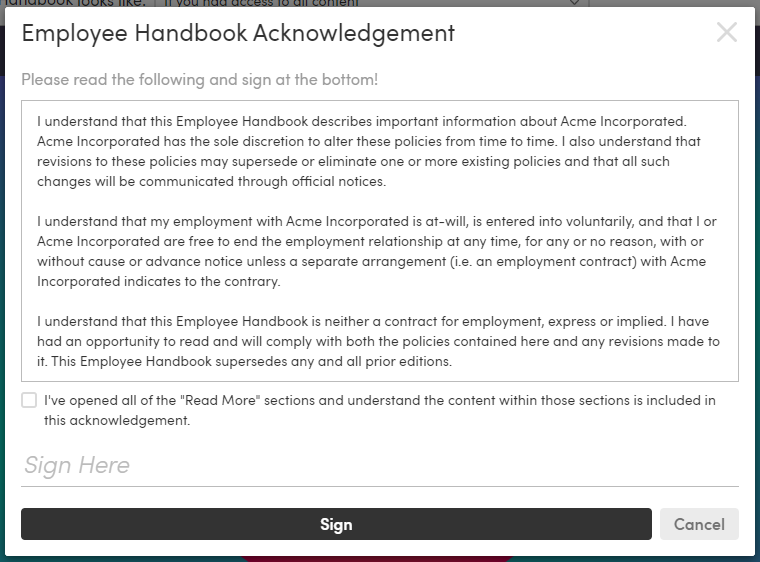
Example #2: Youngstown Ohio Acknowledgement Statement
In this sample acknowledgement statement from the City of Youngstown, Ohio, employees are prompted to confirm they’ve received the handbook. The statement emphasizes the employees’ duty to get acquainted with the guidelines and points them to the right people or departments for any questions. It also gives a heads-up that the handbook might be updated down the road.
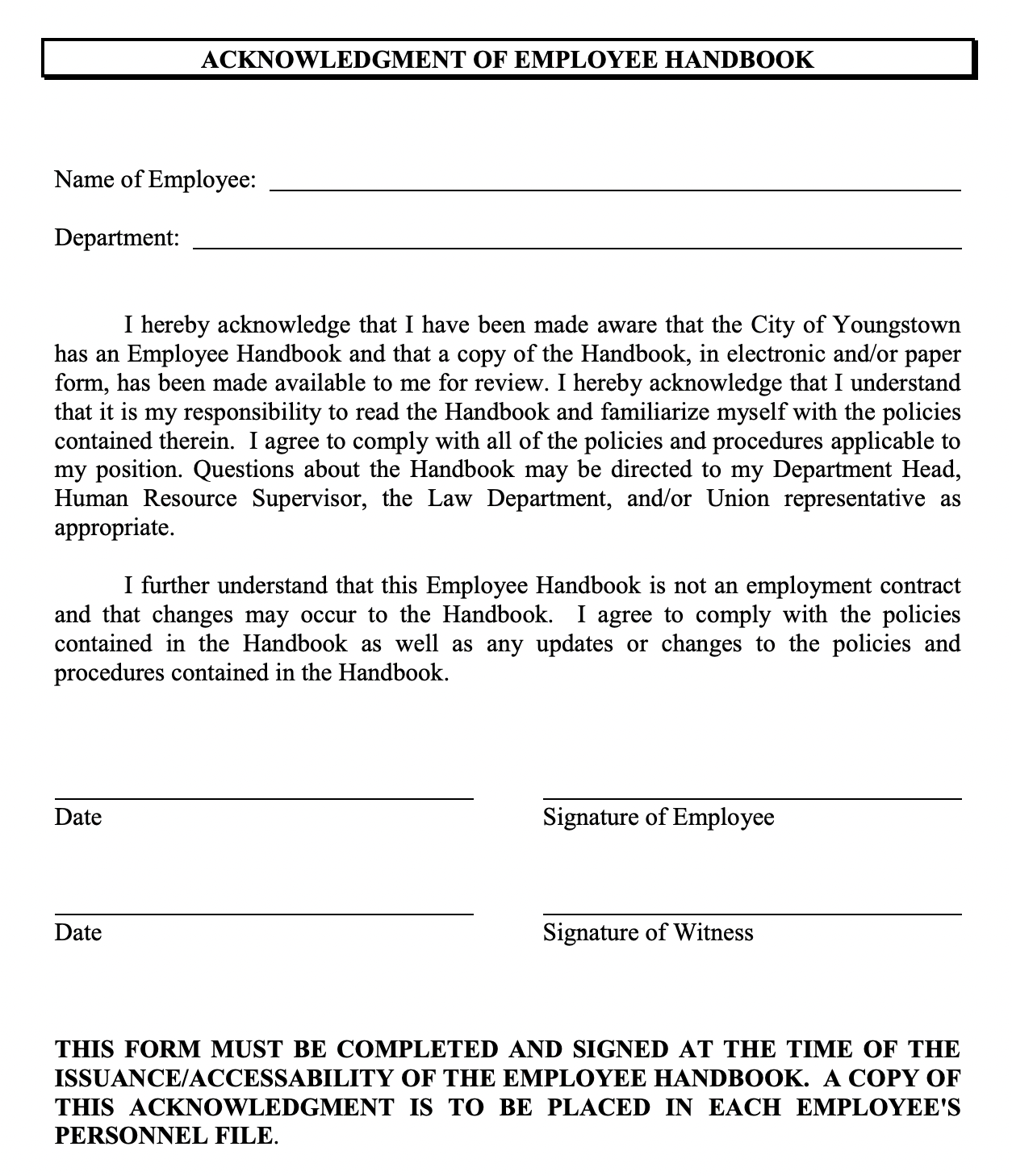
Example #3: Perry City, Utah Acknowledgement Statement
The acknowledgement statement from Perry City is well-structured, ensuring employees are clear about their terms of employment. It details who employees can turn to if they have questions and mentions that the handbook content can change. The statement also makes it clear that employment is at will, meaning no one can promise anything outside of what’s in the handbook. Lastly, any changes to job terms must be approved by the right authorities, showing a clear chain of command.
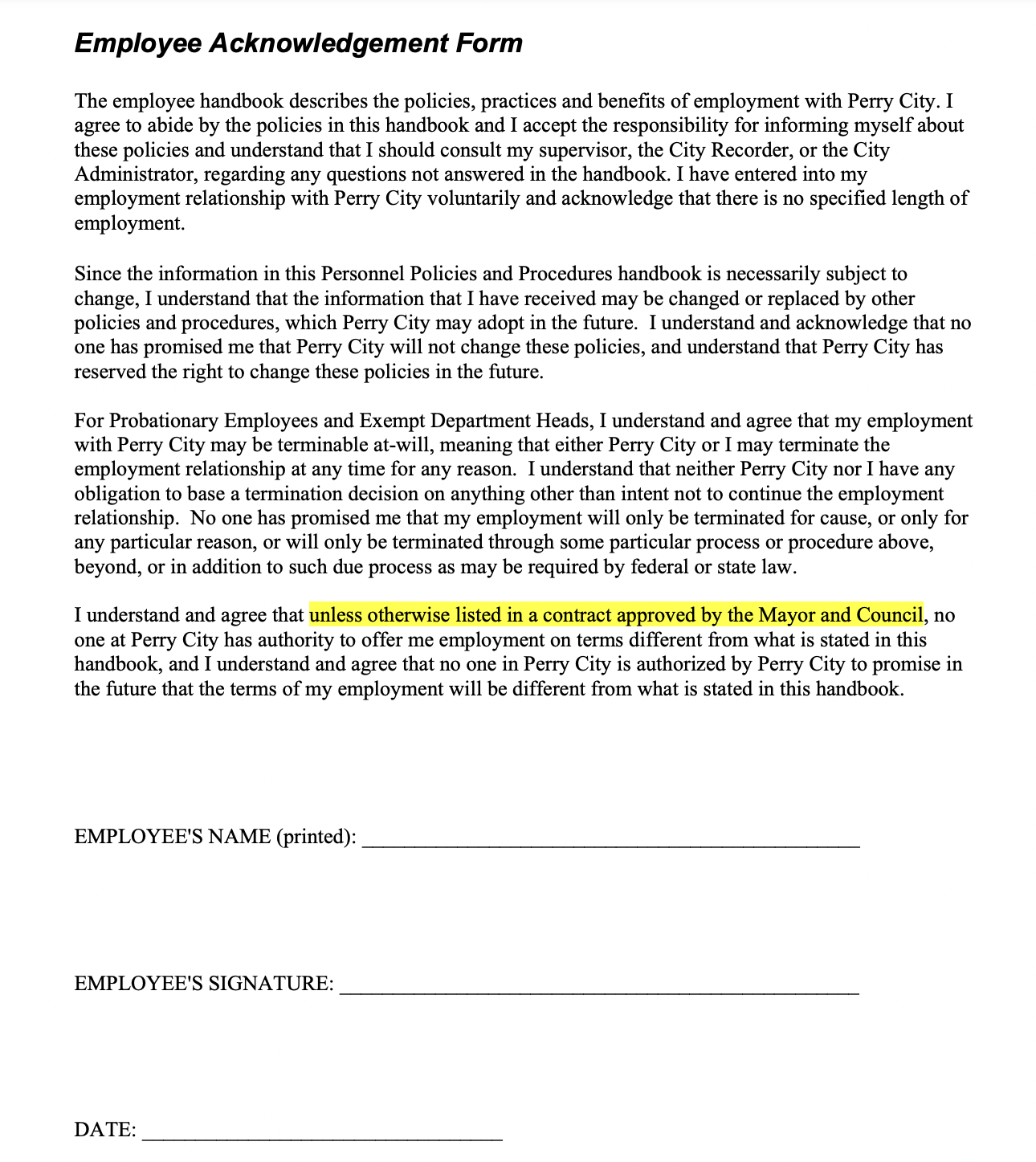
Guidelines on Designing the Acknowledgment Statement
Once you’ve crafted your perfect acknowledgment content, think about its presentation. Whether you’re using Google Docs, Microsoft Word, specialized handbook software like Blissbook, or another platform, ensure the content remains consistent.
When designing an acknowledgement statement, use clear and simple language. Avoid complex jargon to ensure all team members, from interns to managers, grasp its meaning. Everyone should know what they’re signing off on.
You should also make sure your acknowledgement is inclusive. Specifically, be sure to consider the following:
- Employees with Disabilities: Adapt your acknowledgement design to be accessible. Consider Braille for those with sight issues, larger fonts for those with vision challenges, and audio formats for those who prefer listening.
- Multilingual Teams: With diverse teams come diverse languages. Offering translated versions of your handbook and acknowledgement statement is essential. It ensures everyone on the team, regardless of language, understands how to be successful at your organization.
Lastly, consider the placement of the acknowledgement statement. Most handbooks end with this, but you can begin with it to set the tone right from the start. If you opt for the latter, make sure it only confirms receipt since employees can’t acknowledge having read or understood content they haven’t even seen yet.
Considering the two choices, Blissbook stands out as a fantastic tool. It lets you either have employees (1) read the handbook and then sign, or (2) sign first and go through the handbook afterward.
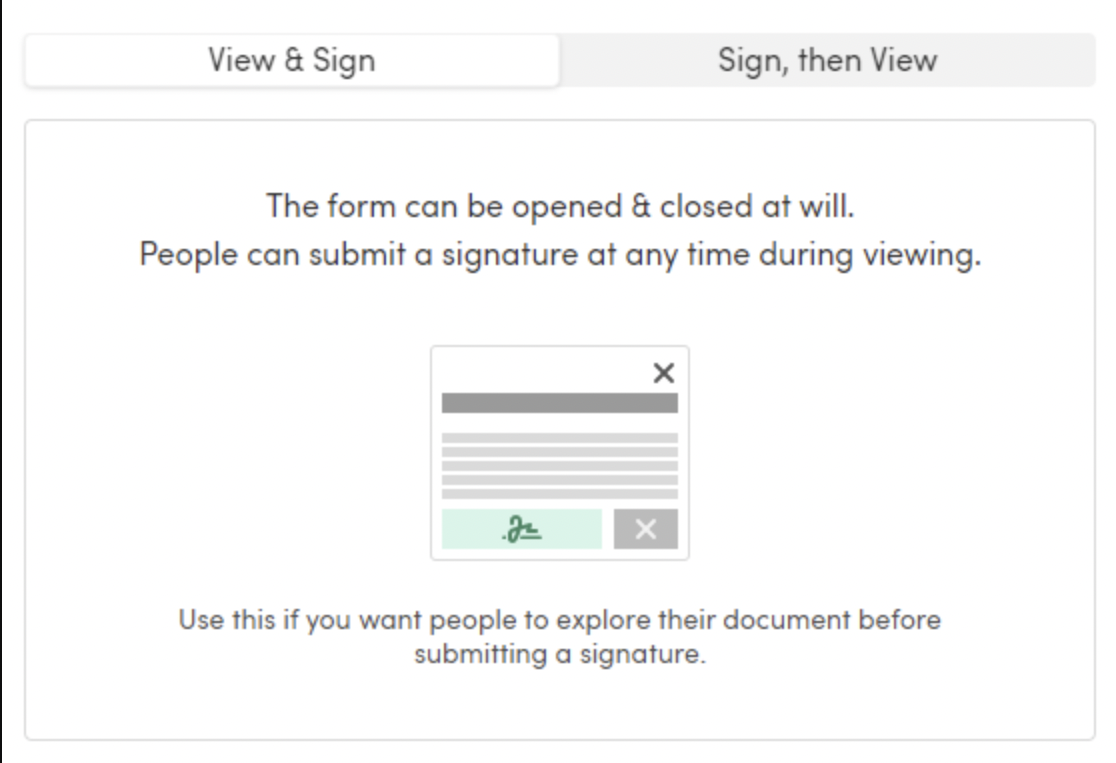
There’s also a section in Blissbook labeled “Acknowledgement.” Just copy your material into this section (or use our acknowledgement statement template and customize it) and the platform takes care of everything else!
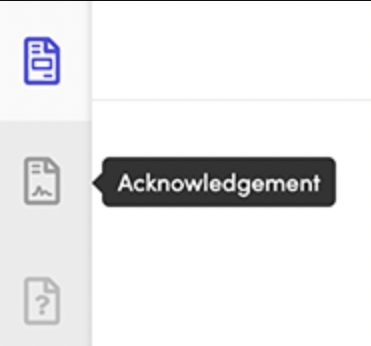
Blissbook also provides an efficient way to collect signatures since employees sign directly within the platform. You can then see who’s signed in the Documentation Center, making the process smooth and traceable. If you’re aiming for an even more streamlined process, consider using automated reminders for employees to sign.
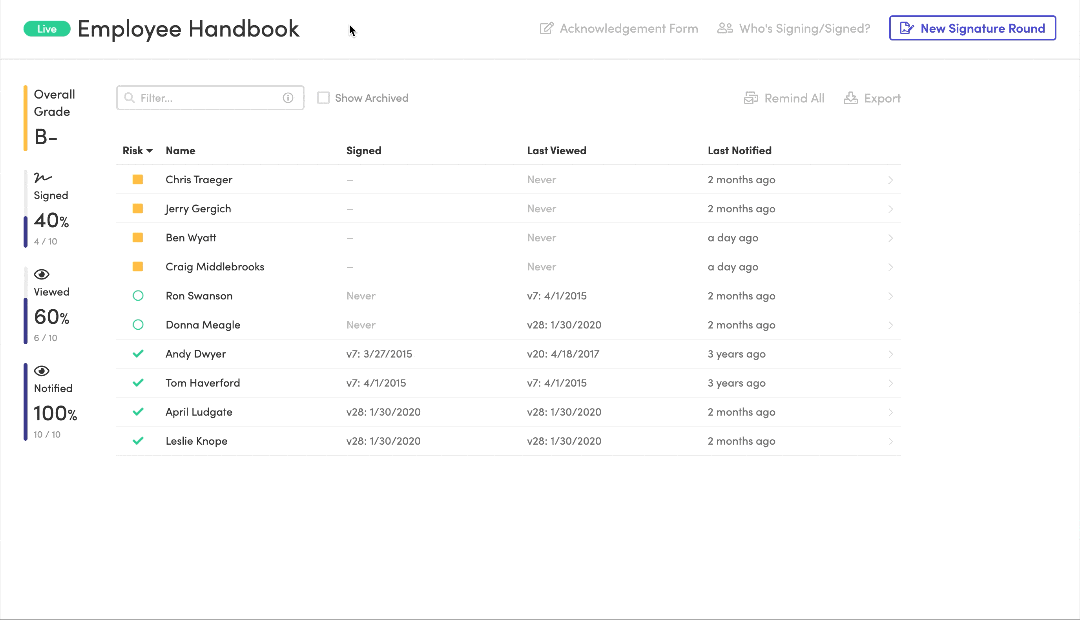
Final Thoughts
Employee handbook acknowledgement may not be thrilling, but it’s a crucial part of the process. It helps turn your handbook from a document into a commitment.
In this piece, we delved into the significance of handbook signature pages, offering top tips, examples, and guidance on crafting your own. A well-designed acknowledgement page can boost employee engagement and improve adherence to your company’s rules.
Looking to simplify and enhance your employee handbook process? Explore what Blissbook can offer now with our free trial.